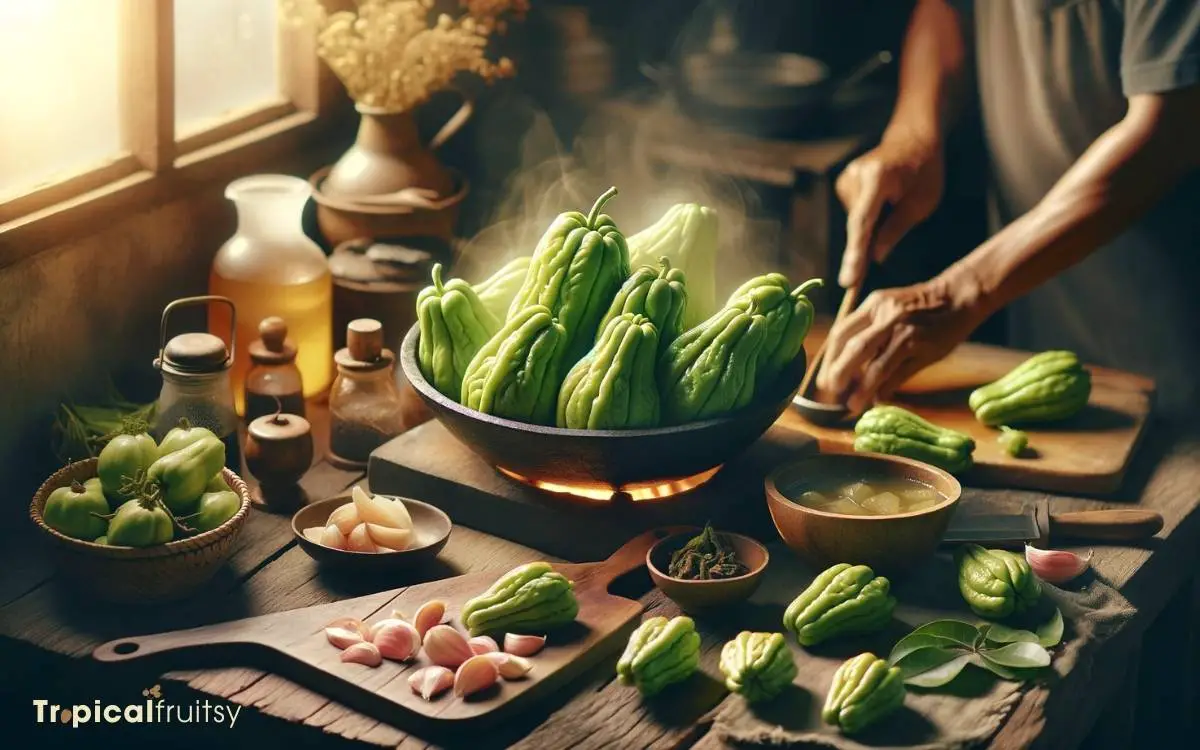How to Cook Chayote Filipino Style? 7 Easy Steps!
To cook chayote Filipino style, often referred to as “Ginisang Sayote”, you will sauté sliced chayote with garlic, onion, tomato, and sometimes pork or shrimp.
This dish is seasoned with fish sauce or salt and pepper, and simmered until the chayote is tender. It’s commonly served with steamed rice.
Ginisang Sayote is a simple yet flavorful Filipino vegetable dish.
Here’s a step-by-step guide:
Some variations might include adding leafy greens like spinach or moringa leaves for added nutrition.
Enjoy the heartwarming taste of home with Ginisang Sayote, a nutritious and comforting Filipino chayote dish perfect for family meals.

Key Takeaway
Step 1: Selecting the Perfect Chayote
We’ll begin our Filipino chayote dish by choosing firm, unblemished chayotes with vibrant green skin. It’s essential to pick the freshest chayotes, as they’re the heart of our traditional recipe.
We feel for chayotes that are heavy for their size, a sign that they’re juicy and haven’t lost their moisture. We avoid any with wrinkled surfaces or blemishes, which indicate age or damage.
The skin should be bright green, without any brown spots or signs of drying out. If you tap it lightly, a good chayote should sound solid and not hollow. We cherish this step, knowing that the quality of our dish relies heavily on the ingredients we select.
Step 2: Preparing Your Ingredients
Before we get our chayote on the stove, we need to master the art of peeling its tough skin.
We’ll measure each ingredient with the care that our lolas taught us, ensuring every bite carries the warmth of tradition.
To cap it off, we’ll explore which flavors will best complement our chayote, just like the time-tested combinations from our family’s recipe book.
Chayote Peeling Techniques
Let’s kick off the preparation by peeling the chayote with a sharp vegetable peeler to ensure a smooth texture for our Filipino dish.
Here’s how we do it:
- First, we wash the chayote under running water to remove any dirt or residue.
- Holding the chayote firmly, we glide the peeler from top to bottom, peeling away the skin in thin strips.
- We rotate the chayote in our hand to peel evenly around its pear-like shape.
- For any stubborn spots, we carefully use a paring knife to remove the skin without wasting the flesh.
- Lastly, we rinse the peeled chayote once more to ensure it’s clean and ready for cooking.
Peeling chayote might seem like a humble start, but it’s the foundation of a delicious Filipino meal.
Ingredient Portioning Guide
After peeling the chayote, we’re ready to measure and prepare the remaining ingredients for our Filipino dish. We’ll need to finely chop one large onion and mince four cloves of garlic to lay the aromatic foundation.
For a touch of savory depth, let’s thinly slice 200 grams of pork. To balance the flavors, we’ll cut two medium tomatoes into wedges.
Traditionally, we use patis (fish sauce) for seasoning, so let’s measure out two tablespoons. We’ll also need a cup of water to help soften the chayote as it simmers.
Lastly, we’ll prepare a bunch of malunggay leaves or spinach, meticulously plucked from their stems for that burst of green and nutrients.
Now, with everything portioned, we’re set to cook with the spirit of the Filipino kitchen.
Flavor Pairing Suggestions
As we combine our prepped ingredients, we’ll explore how their flavors marry to create a quintessentially Filipino taste profile.
Our chayote will be at the heart of the dish, but it’s the harmony of the following elements that will bring out its best:
- Garlic and onions: These aromatics form the base of our dish, infusing it with a heady scent and deep flavors.
- Tomatoes: Their acidity and sweetness balance the chayote’s mild taste.
- Pork or shrimp: Adding a savory depth, choose one that suits your preference.
- Fish sauce or soy sauce: A splash brings the umami that Filipino cuisine is famous for.
- Ground black pepper: Just a pinch to add a subtle heat.
With our ingredients ready, let’s turn to mastering the sauté technique, ensuring each component melds perfectly.
Step 3: Mastering the Sauté Technique
We’ll begin by heating oil in a pan to sauté our chayote, ensuring it’s cooked evenly for authentic Filipino flavor.
The key is to keep the heat at a medium to allow the chayote to soften without burning. We’re aiming for a tender bite, a hallmark of Filipino cooking.
We’ll stir frequently and attentively, allowing the natural sugars to caramelize slightly, which brings out the vegetable’s inherent sweetness.
It’s vital not to rush this process; patience is our ally here. Our ancestors took pride in their ability to coax out flavors, and we honor that tradition.
Once the chayote has achieved a golden hue, we’ll introduce our aromatic ingredients. Garlic, onion, and tomato are essentials, melding their flavors with the chayote to create a dish that’s both simple and profound.
Step 4: Crafting the Perfect Broth
Having sautéed our chayote to perfection, we now turn our attention to crafting a broth that’ll enrich the dish with robust flavors. The soul of Filipino cooking lies in the harmony of its ingredients, and the broth is no exception.
Here’s what we’ll need:
- A generous pour of chicken or vegetable stock
- A splash of fish sauce for that umami depth
- Sliced onions and garlic for aromatic essence
- Whole peppercorns to infuse a subtle spice
- Bay leaves for a hint of herby sweetness
We carefully combine these elements, ensuring each one melds together to form a traditional base that’s hearty and soul-warming.
Now, let’s get ready to simmer our concoction, allowing the flavors to deepen and blend for optimal taste.
Step 5: Simmering for Optimal Flavor
Bringing our broth to a gentle simmer, we’ll let the flavors meld and intensify, ensuring the chayote absorbs every hint of savory goodness.
As it simmers, the chayote becomes tender, a perfect canvas for the rich tapestry of flavors we’ve crafted. We watch over our pot, stirring occasionally, as our ancestors did, with patience and anticipation.
| Ingredient | Role in Simmering |
|---|---|
| Chayote | Absorbs flavors |
| Garlic | Infuses aroma |
| Pepper | Adds subtle heat |
| Broth | Unifies the dish |
In this cherished ritual, we’re not just cooking; we’re weaving a story of our heritage into every bite. The simmering is where the magic happens, and we ensure it’s done just right.
Now, as the chayote is fully infused with flavor, we’re ready to elevate our dish further by adding traditional garnishes.
Step 6: Adding Traditional Garnishes
As we garnish our chayote dish, we’re mindful of the rich culinary heritage that our Filipino ancestors have passed down to us.
We choose toppings like fried garlic bits, diced spring onions, and a squeeze of calamansi to honor the traditional flavors that have seasoned our palates for generations.
These garnishes not only add vibrant colors and textures but also deepen the dish’s authentic taste.
Selecting Authentic Toppings
We’ll enhance our chayote dish with traditional Filipino toppings like crushed chicharron, fried garlic bits, and fresh scallions.
These garnishes aren’t just for show; they’re steeped in our culinary heritage, bringing out the best in every bite.
Here’s what we typically reach for:
- Crushed chicharron: The salty crunch adds a delightful texture.
- Fried garlic bits: These golden morsels infuse a nutty flavor.
- Fresh scallions: Sliced thinly for a mild, oniony zest.
- Toasted sesame seeds: A sprinkle brings a subtle, earthy touch.
- Sautéed shrimp paste (bagoong): For an umami-packed kick.
Each of these toppings is selected to complement the mild taste of chayote, creating a harmony of flavors that’s uniquely Filipino. Let’s dive in and give our dish that authentic flair.
Incorporating Regional Flavors
Let’s infuse our chayote dish with five distinct regional garnishes that celebrate the diverse flavors of the Philippines.
In Luzon, we often add a crunch with tinapa flakes, smoked fish that brings a depth of flavor. Visayas is known for its hilaw na mangga, green mangoes that add a tangy zest.
Over in Mindanao, tabon-tabon, a native fruit, is used to remove any fishy taste, enhancing the chayote’s natural sweetness. We also love to sprinkle fried garlic bits for a savory kick, common across the archipelago.
And we can’t forget the bagoong, a fermented fish or shrimp paste that’s a staple in every Filipino kitchen.
Each garnish is steeped in tradition, turning our chayote into a dish that’s a true mosaic of our culinary heritage.
Step 7: Serving and Pairing Ideas
We’ve rounded up some delightful pairings and serving suggestions to complement your Filipino-style chayote dish. When we present this versatile vegetable, we ensure it’s surrounded by flavors that enhance its subtle taste.
Here are our top picks:
- Steamed white rice: The perfect canvas for the chayote’s gentle flavor.
- Grilled fish or pork: A smoky counterpart to the chayote’s fresh crispness.
- Pickled papaya (atchara): Adds a sweet and tangy contrast that’s traditionally Filipino.
- A side of adobo: The rich, savory sauce marries well with the chayote’s lightness.
- Fresh tomato salad: A vibrant, acidic complement to the dish’s earthy tones.
Together, these components create a harmony on the plate, ensuring each bite is as satisfying as the last.
Conclusion
We’ve simmered our chayote to perfection, like pearls glistening in a rich, savory broth. While the heady aroma fills the kitchen, we can’t help but beam with pride.
Our Filipino-style chayote is a true testament to tradition, each bite a celebration of home-cooked warmth. As we ladle it out, we know it’ll pair beautifully with steaming rice, bringing comfort to the table.
Here’s to cooking from the heart, and sharing meals that bind us together. Mabuhay!





